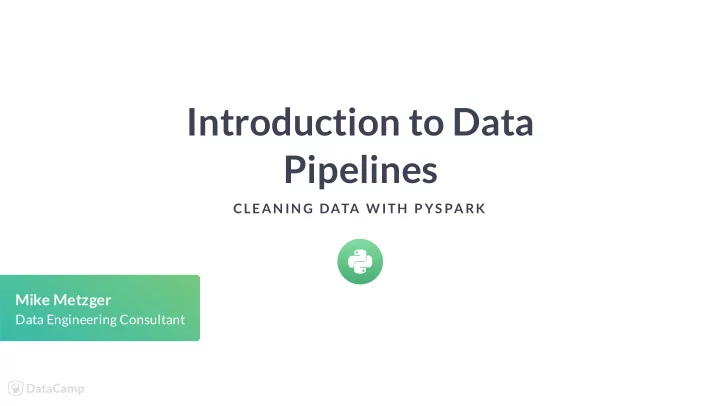

Introduction to Data Pipelines CLEAN IN G DATA W ITH P YS PARK Mike Metzger Data Engineering Consultant
What is a data pipeline? A set of steps to process data from source(s) to �nal output Can consist of any number of steps or components Can span many systems We will focus on data pipelines within Spark CLEANING DATA WITH PYSPARK
What does a data pipeline look like? Input(s) CSV, JSON, web services, databases Transformations withColumn() , .filter() , .drop() Output(s) CSV, Parquet, database Validation Analysis CLEANING DATA WITH PYSPARK
Pipeline details Not formally de�ned in Spark Typically all normal Spark code required for task schema = StructType([ StructField('name', StringType(), False), StructField('age', StringType(), False) ]) df = spark.read.format('csv').load('datafile').schema(schema) df = df.withColumn('id', monotonically_increasing_id()) ... df.write.parquet('outdata.parquet') df.write.json('outdata.json') CLEANING DATA WITH PYSPARK
Let's Practice! CLEAN IN G DATA W ITH P YS PARK
Data handling techniques CLEAN IN G DATA W ITH P YS PARK Mike Metzger Data Engineering Consultant
What are we trying to parse? Incorrect data width, height, image Empty rows Commented lines # This is a comment Headers 200 300 affenpinscher;0 Nested structures Multiple delimiters 600 450 Collie;307 Collie;101 Non-regular data 600 449 Japanese_spaniel;23 Differing numbers of columns per row Focused on CSV data CLEANING DATA WITH PYSPARK
Stanford ImageNet annotations Identi�es dog breeds in images Provides list of all identi�ed dogs in image Other metadata (base folder, image size, etc.) Example rows: 02111277 n02111277_3206 500 375 Newfoundland,110,73,416,298 02108422 n02108422_4375 500 375 bull_mastiff,101,90,214,356 \ bull_mastiff,282,74,416,370 CLEANING DATA WITH PYSPARK
Removing blank lines, headers, and comments Spark's CSV parser: Automatically removes blank lines Can remove comments using an optional argument df1 = spark.read.csv('datafile.csv.gz', comment='#') Handles header �elds De�ned via argument Ignored if a schema is de�ned df1 = spark.read.csv('datafile.csv.gz', header='True') CLEANING DATA WITH PYSPARK
Automatic column creation Spark will: Automatically create columns in a DataFrame based on sep argument df1 = spark.read.csv('datafile.csv.gz', sep=',') Defaults to using , Can still successfully parse if sep is not in string df1 = spark.read.csv('datafile.csv.gz', sep='*') Stores data in column defaulting to _c0 Allows you to properly handle nested separators CLEANING DATA WITH PYSPARK
Let's practice! CLEAN IN G DATA W ITH P YS PARK
Data validation CLEAN IN G DATA W ITH P YS PARK Mike Metzger Data Engineering Consultant
De�nition Validation is: Verifying that a dataset complies with the expected format Number of rows / columns Data types Complex validation rules CLEANING DATA WITH PYSPARK
Validating via joins Compares data against known values Easy to �nd data in a given set Comparatively fast parsed_df = spark.read.parquet('parsed_data.parquet') company_df = spark.read.parquet('companies.parquet') verified_df = parsed_df.join(company_df, parsed_df.company == company_df.company) This automatically removes any rows with a company not in the valid_df ! CLEANING DATA WITH PYSPARK
Complex rule validation Using Spark components to validate logic: Calculations Verifying against external source Likely uses a UDF to modify / verify the DataFrame CLEANING DATA WITH PYSPARK
Let's practice! CLEAN IN G DATA W ITH P YS PARK
Final analysis and delivery CLEAN IN G DATA W ITH P YS PARK Mike Metzger Data Engineering Consultant
Analysis calculations (UDF) Calculations using UDF def getAvgSale(saleslist): totalsales = 0 count = 0 for sale in saleslist: totalsales += sale[2] + sale[3] count += 2 return totalsales / count udfGetAvgSale = udf(getAvgSale, DoubleType()) df = df.withColumn('avg_sale', udfGetAvgSale(df.sales_list)) CLEANING DATA WITH PYSPARK
Analysis calculations (inline) Inline calculations df = df.read.csv('datafile') df = df.withColumn('avg', (df.total_sales / df.sales_count)) df = df.withColumn('sq_ft', df.width * df.length) df = df.withColumn('total_avg_size', udfComputeTotal(df.entries) / df.numEntries) CLEANING DATA WITH PYSPARK
Let's practice! CLEAN IN G DATA W ITH P YS PARK
Congratulations and next steps CLEAN IN G DATA W ITH P YS PARK Mike Metzger Data Engineering Consultant
Next Steps Review Spark documentation Try working with data on actual clusters Work with various datasets CLEANING DATA WITH PYSPARK
Thank you! CLEAN IN G DATA W ITH P YS PARK
Recommend
More recommend